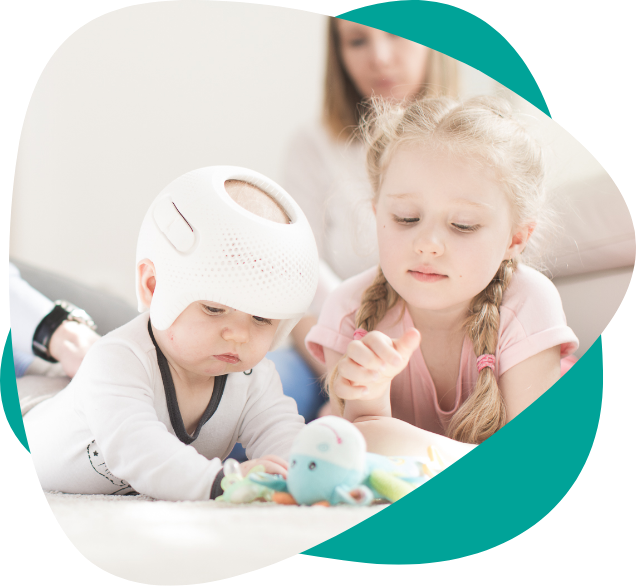Repositioning Guide
- Home >
- Community And Resources >
- Repositioning Guide
At about eight weeks of age, many parents start to notice that their baby has started to develop a flattening of the head. At this age, we always recommend trying some repositioning techniques for plagiocephaly, to try and prevent your baby from putting any additional or excessive pressure on the flat spot, while they are sleeping or awake. Here are some hints and tips on baby repositioning techniques that could help to improve your baby’s head shape, before needing to think about using a plagiocephaly helmet.

Plagiocephaly Head Repositioning During Sleep and At Night
Our first piece of advice is to always place your baby on their back to sleep, not on their side and definitely not in your bed. This advice has reduced the incidence of sudden infant death hugely. For more information on minimising the risk of Sudden Infant Death Syndrome (SIDS), see the Lullaby Trust website.
- Babies may need your help to change their head position until they can do it on their own. As your baby sleeps, gently turn their head to vary the position.
- Change the position of toys and other interesting things that your baby looks at, from one side to the other.
- Babies who suck a thumb tend to turn towards that side. Try covering the thumb that is sucked or encourage them to suck the opposite one.
- To encourage your baby to look at the other side and lean on the other side of their head, alternate the end of the cot where your baby lies.
- If your baby sleeps in a crib or Moses basket in your bedroom, turn this around regularly so that your baby is not looking in the same direction all of the time.
- We cannot comment on or recommend the use of pillows or sleep positioners in the cot. Please read our dedicated blog post on the safety risks of using such products for more information.

Baby Repositioning Techniques When Awake During the Day
We recommend removing pressure from the back of your baby’s head for at least half of the time that your baby is awake. There are a few ways to relieve this pressure:
- Don’t feed your baby from the same side every time. If you are breastfeeding, you will be doing this naturally. But if you are feeding with a bottle, alternate the side from which you
- Use a carry sling to carry your baby – these are good as they free the back of your baby’s head from any pressure.
- Take your baby out of their car seat/buggy when you are not travelling. It is easy to carry your baby in a car seat, but this has started to be called ‘Container Baby Syndrome’ (CBS). It is a relatively new term used in paediatrics to describe a baby that spends a majority of his/her time in some sort of enclosed space. These ‘containers’ can include car seats, bouncy swings, vibrating chairs, Bumbo seats or other devices that ‘contain’ a baby’s movement.
- Do not place your baby flat on their back on a firm surface in a play gym.
- When sitting, try not to let your baby sit back against you. This is a really easy position and doesn’t encourage core strength to develop in the trunk or neck. Instead, sit your baby across your leg like a riding horse, slightly leaning forward with your arms around the body.
- When sitting or feeding, avoid using an infant carrier, car seat, or buggy insert too much. There are several seats on the market that allow infants over four months of age to sit without pressure to the back of the head.
- If your baby has a tight neck or torticollis, which means that one of the side neck muscles is much tighter than the other, we recommend that you see a physiotherapist or osteopath as soon as you notice it. Although most infants with torticollis simply have a tight muscle, there are some causes of the condition where you should seek medical attention before working on stretches to improve the range of motion in the neck. Carrying your baby in a ‘sleeping tiger’ position will help to improve the range of motion on the side.
For more examples of the best ways to carry your baby safely, please read our blog post specifically dedicated to the topic.
Tummy Time
This plagiocephaly infant repositioning technique involves placing your baby on their tummy to play while they are awake and you are with them. This is a great exercise as they learn how to prop their arms and develop the spinal extensors and hips. If your baby struggles, try rolling up a towel and placing it under their chest to offer them additional support.
Some parents struggle with tummy time if their baby starts to cry, as some do not like to go onto their tummy. If this is the case, we suggest starting a little more gently using the following baby repositioning techniques:
- Cross your knees and lie your baby across them with their arms propping on your crossed knee and your hand supporting under the bottom.
- Carry your baby face down along your forearm like a sleeping tiger.
- Carry your baby facing out rather than cradled in your arm.
- Use a papoose or carrying sling.
These simple methods help to improve your baby’s strength, spine and neck control and can lead to a reduction in the tendency for a flattening to develop.
If you are not seeing significant improvement by the age of five months, cranial remoulding will improve the head shape much more rapidly, and a better, fuller improvement can occur.

What to do if Plagiocephaly Repositioning isn’t Working
If by the age of four or five months you do not see any significant improvement, please call us on 0330 100 1800 to make an appointment for a free no-obligation assessment with one of our expert clinicians. At the appointment, your clinician will assess your baby’s head shape, and discuss the available options available for your baby based on this assessment.
What to do if Plagiocephaly Repositioning isn’t Working
If by the age of four or five months you do not see any significant improvement, please call us on 0330 100 1800 to make an appointment for a free no-obligation assessment with one of our expert clinicians. At the appointment, your clinician will assess your baby’s head shape, and discuss the available options available for your baby based on this assessment.
If you are still concerned and would like some advice from our specialists, please get in touch.